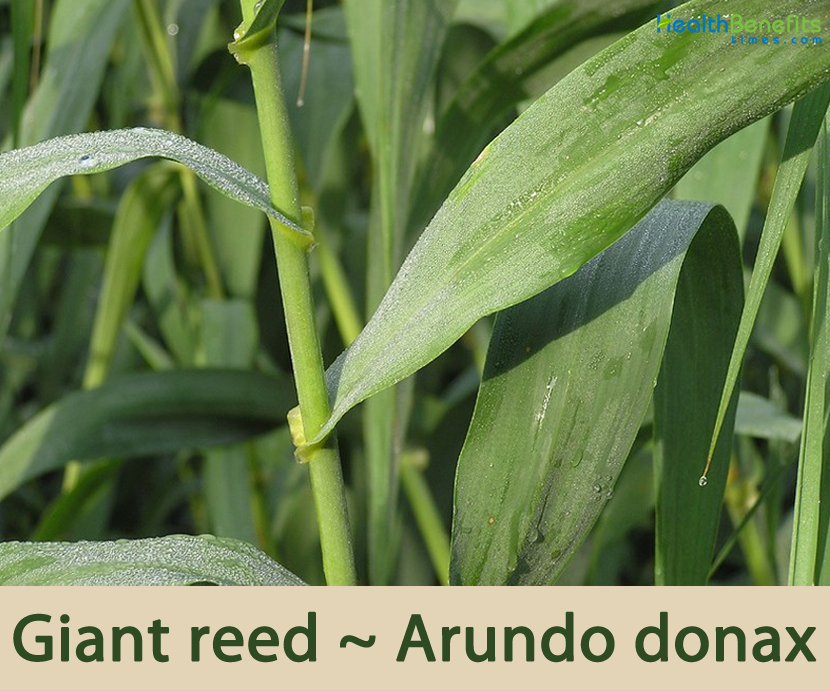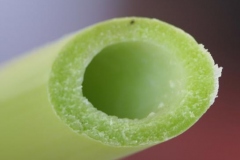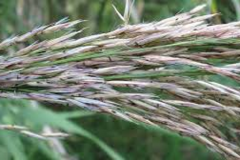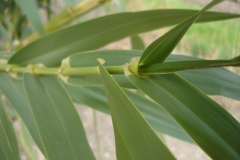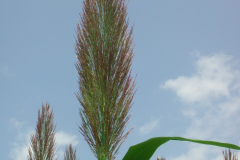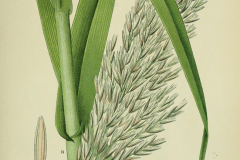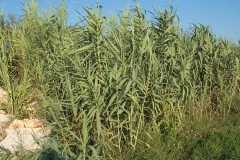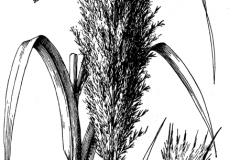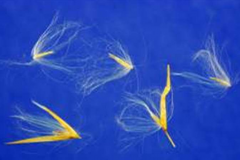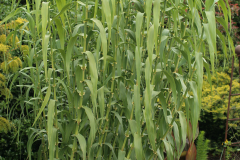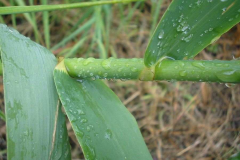Some of the popular common names of the plant are Giant Reed, Giant Reed Grass, bamboo reed, giant cane, spanish reed, wild cane, Spanish cane, Colorado river reed, arundo, bamboo, carrizo, Danubian reed, elephant grass, false bamboo, giant Danube reed, Colorado river reed, green bamboo reed, Cow cane and arundo grass. Genus name Arundo comes from the Latin word arundo which means a reed. The plant has a wide range of applications and is often cultivated for use in basket making and to control soil erosion. The plant is often cultivated in warm temperate to tropical areas as an ornamental. Widely grown as an ornamental, the plant can easily escape from cultivation and become naturalized. It has been declared ‘Invasive’ in many countries. Once established, it can form huge colonies, sometimes covering hundreds of acres. It is highly flammable and resprouts quickly after burning. Fires help transform communities of native plants into solid stands of giant reed, changing riverbank forests from flood- to fire-defined habitats.
Giant Reed Facts
| Giant reed Quick Facts | |
|---|---|
| Name: | Giant reed |
| Scientific Name: | Arundo donax |
| Origin | Mediterranean area, introduced to many subtropical and warm temperate regions |
| Shapes | Dry, hairy, 3-8 mm long with an awn to 3 mm long |
| Health benefits | Support herpes, stimulate appetite, increase sperm, purify urine, muscle aches, pains and stiffness, gonorrhea, headaches, dropsy, cancer, broken limbs, pertussis and cystitis |
| Name | Giant reed |
|---|---|
| Scientific Name | Arundo donax |
| Native | Mediterranean area, introduced to many subtropical and warm temperate regions. It has been cultivated throughout Asia, southern Europe, northern Africa and the Middle East for thousands of years. In North America, it was intentionally introduced from theMediterranean to the Los Angeles area |
| Common Names | Giant Reed, Giant Reed Grass, bamboo reed, giant cane, spanish reed, wild cane, Spanish cane, Colorado river reed, arundo, bamboo, Danubian reed, elephant grass, false bamboo, giant Danube reed, green bamboo reed, Cow cane, arundo grass |
| Name in Other Languages | Afrikaans: Spaanse-riet Albanian: Kallami Arabic: Ghab, Qalam, Ghaab, qasib (قصيب), alghab aleimlaq (الغاب العملاق), bus hajnaa (بوص حجنى), bus rashidaa (بوص رشيدى), ghab (ghab) (غاب (غَاب), ghab baldaa (ghab balada) (غاب بلدى (غَاب بَلَدى)) Australia: Bamboo, Danubian reed, e-grass, elephant grass, giant Danube grass, oboe reed Azerbaijani: Qamışvari qarğı Basque: Kanabera Bengali: Nāla (নাল) Brazil: Cana do brejo, cana do reino, cana-brava, canno do reino, capim plumoso, taquara-do-reino Bulgarian: Italianska trŭstika (италианска тръстика) Burmese: A lo kyauu pain (အလိုကျူပင်) Catalan: Canya, canya comuna, canya de sant Joan Chile: Cañamo Chinese: Lu zhu (芦竹), lú dí (蘆荻) Colombia: Caña brava Costa Rica: Caña hueca Croatian: Obični trst Cuba: Caña de Castilla, caña de río, caña hueca, cañita de la india Czech: Tresť obecná Dominican Republic: Cañita Dutch: Pijlriet, zaairiet English: Spanish reed, bamboo reed, giant reed, green bamboo reed, wild cane, Cow cane, giant cane, arundo grass, cane, giant reed grass Fijian: Ngasau ni vavalangi Finnish: Jättiruoko French: Canne de Provence, Roseau à quenouilles, Grand Roseau, arondo donax, cannevelle, quenouille, roseau canne, roseau de Fréjus, roseau des jardins, roseau donax Galician: Cana German: Pfahlrohr, gewöhnliches Pfahlrohr, italienisches Pfahlrohr, Pfeilrohr, Riesenpfahlrohr, Riesenschilf, spanisches Rohr Greek: Kalami (καλάμι), Kalamin Haiti: Herbe Roseau, Roseau Hebrew: Avkaneh shachiach, ebknh shkhikh (עַבְקָנֶה שָׁכִיחַ) Hindi: Nal, Narkat ghass, narakat (नरकट), Baranal, baru, Doka, Nal, naldura Hungarian: Óriás olasznád Italian: Canna Domestica, canna commune, canna commune, canna di Provenza, canna gargana, canna gentile Japanese: Danchiku (ダンチク), yoshitake (ヨシタケ) Kannada: Baalada kaddi, bilee laalada kaddi, hulagilu hullu Korean: Mul dae (물대) Macedonian: Italijanska trska (италијанска трска) Malayalam: Oodappullu, īṟa (ഈറ) Manipuri: Yengdou Maltese: Qasba Marathi: Nal Mizo: Pum-phir Nepali: Thulo narkat (थुलो नरकट), narkat (नर्कट) Netherlands: Pijlriet Norwegian: Kjemperør Occitan: Canavèra, cannabère Persian: قمیش Polish: Lasecznica trzcinowata Portuguese: Cana, Cana-comum, Cana-do-reino, Canavieira, Taquara-do-reino, cana palustre, cana-de-roca, cana-vieira, canamilha, canas, caninha, cano-do-reino Puerto Rico: Caña gigante, guajana Romanian: Trestie italiană Russian: arundo trostnikovyy (арундо тростниковый), trostnik gigantskiy (тростник гигантский ) Samoan: Ofe, ‘ofe teu fale, fiso pālagi Sanskrit: Dhamana, nala, potagala Sardinian: Canna Serbian: Italijanska trska (италијанска трска) Slovak: Trsť obrovská Slovene: Navadna kanela South Africa: Spaanse-riet Spanish: Bardiza, Canya, Canyer, Carda, Caña, Caña común, Caña de Castilla, Caña Silvestre, Cañavera, Cañizo, Licera, Morsana común, caña de la reina, caña de techar, Carrizo, falso bamboo, gallipato alcublano, junco gigante, caña gigante, cañaveral, caña india, carrizo grande, narkhat, Navadni trstikovec Swedish: Italienskt rör Tamil: Caravanam, koraikkuccu, korukachi, Eruvai (pul) (எருவை (புல்) Telugu: Adavikikasa-gaddi, adavikikkasagadi, kaki veduru (కాకివెదురు), paatuveduru, patu veduru, peepalu, Thai: อ้อ Tongan: Kaho, kaho lalahi, kaho pāpālangi, kaho folalahi Tunisian Arabic: Qasab (قصب) Turkish: Kargi Upper Sorbian: Hoberska sćina Uruguay: Caña musical Vietnamese: Lau |
| Plant Growth Habit | Tall, fast-growing, erect, herbaceous, perennial, semiaquatic rhizomatous cane or reed-like grass |
| Growing Climates | Moist areas, such as along ditches, riverbanks, hillsides, open forest, roadsides, marshland, sand dunes near seashores, lakesides, edges of stream and ponds, flood plains, coastal areas, irrigation ditches, waste ground, moist forests, shrub lands and domestic gardens |
| Soil | Grows in a wide range of soils, from coarse sands or gravelly soils to heavy clays and river sediments, and from freshwater to semi-saline soils on brackish estuaries, as it has a degree of salt tolerance |
| Plant Size | 6 meters (20 ft.) in height, or in ideal conditions can exceed 10 meters (33 ft.) and a stem diameter up to 1.5 inches |
| Root | Root structure is very strong, with the fleshy, almost bulbous, creeping rootstocks (rhizomes) forming compact bundles from which grow the fibrous roots, penetrating deep into the soil |
| Stem | 1-8 cm (0.25-2 in) tall, thick, hollow, short distance between nodes results in crowded appearance, resembles a corn stalk |
| Leaf | Large about 5-100 cm long and 1-8 cm wide, lance-shaped (i.e. lanceolate) or very elongated (i.e. linear) in shape, and have a pointed tip (i.e. acute apex). These leaves are alternately arranged along the stems |
| Flowering season | March and September |
| Flower | Numerous feathery flower spikelets (8-15 mm long) are borne on short stalks on the seed-head branches and bear long silky, whitish-coloured, hairs (8-10 mm long). These flower spikelets each have 4 or 5 tiny flowers (i.e. florets) and two bracts (i.e. glumes) as the base. |
| Fruit Shape & Size | Dry, hairy, 3-8 mm long with an awn to 3 mm long |
| Propagation | By rhizomes and stem nodes |
| Plant Parts Used | Rhizome, root leaves and stem |
| Season | October |
Plant Description
Giant reed is a tall, fast-growing, erect, herbaceous, perennial, semiaquatic rhizomatous cane or reed-like grass that normally grows about 6 meters (20 ft.) in height and in ideal conditions can exceed 10 meters (33 ft.) and a stem diameter up to 1.5 inches. It is one of the largest of the herbaceous grasses. The plant is found growing in moist areas, such as along ditches, riverbanks, hillsides, open forest, roadsides, marshland, sand dunes near seashores, lakesides, edges of stream and ponds, flood plains, coastal areas, irrigation ditches, waste ground, moist forests, shrub lands and domestic gardens. The plant grows in a wide range of soils, from coarse sands or gravelly soils to heavy clays and river sediments and from freshwater to semi-saline soils on brackish estuaries, as it has a degree of salt tolerance.
Root & Stem
Its root structure is very strong, with the fleshy, almost bulbous, creeping rootstocks (rhizomes) forming compact bundles from which grow the fibrous roots, penetrating deep into the soil. The horizontal rhizomes give rise to many-stemmed, hollow, cane-like clumps allowing it to form large colonies many meters across. These tough, individual stems or culms are divided by partitions at the nodes like in bamboo, each node 12-30 cm in length and can reach diameters of 1-4 cm with walls 2-7 mm thick. They commonly branch during the second year of growth, rarely multiple, just single lateral branches from nodes. The outer tissue of the stem is of a silicaceous nature, hard and brittle with a smooth glossy surface that turns pale yellow when the culm is fully mature. The culms can remain green throughout the year but often fade with semi-dormancy during the winter or in droughts.
Leaves
The leaves are usually very large about 5-100 cm long and 1-8 cm wide, lance-shaped (i.e. lanceolate) or very elongated (i.e. linear) in shape, and have a pointed tip (i.e. acute apex). These leaves are alternately arranged along the stems and consist of a stem-clasping leaf sheath and a spreading leaf blade. There is a small structure (i.e. ligule) where the leaf sheath meets the leaf blade. It consists of a short membranous flap topped with hairs 1.5-3 mm long (i.e. the ligule is a ciliated membrane).
Flowers
The seed-head (i.e. inflorescence) is a very large plume-like open panicle about 30-70 cm long that barely extends beyond the uppermost leaf. This seed-head is much-branched and relatively dense with large numbers of flower spikelets. Young seed-heads are initially light brown or purplish in color but usually turn whitish or beige in color as they mature. The numerous feathery flower spikelets (8-15 mm long) are borne on short stalks on the seed-head branches and bear long silky, whitish-coloured, hairs (8-10 mm long). These flower spikelets each have 4 or 5 tiny flowers (i.e. florets) and two bracts (i.e. glumes) as the base. The bracts (i.e. glumes) are brownish or purplish in color and 11-13 mm long. Flowering occurs mainly from late spring through to early winter.
Fruits
The flower spikelets break up at maturity (i.e. they disarticulate above the glumes) leaving the bracts (i.e. glumes) remaining on the seed-head. The small (1-2 mm long) oblong ‘seeds’ (i.e. grains or caryopses) are enclosed in two papery bracts (i.e. the palea and lemma).
Traditional uses and benefits of Giant Reed
- The plant enables digestion, clears phlegm, repels bile, purifies blood, and diminishes heat.
- It relieves aches and pains in the heart, bladder and uterus, in addition to curing herpes, stimulating appetite, increasing sperm, purifying urine and strengthening breathing.
- Dried leaves can be brewed with tea leaves and taken to stimulate appetite, promote virility, stop vomiting, remedy passing of blood, and relieve muscle aches, pains and stiffness.
- Root is used as diuretic, for urine purification, gonorrhea, itchy skin, and menstrual flow stimulation.
- The root mass is boiled in water, and the resulting liquid is ingested.
- Adding the powder of the tiger cowry (Cypraea Tigris) to the liquid in which the root mass has been boiled and ingesting the mixture used to treat women for the red or white discharges of gonorrhea.
- An infusion is said to stimulate menstrual discharge and diminish milk flow.
- Paste of the root is applied to the forehead to treat headaches.
- Isolated alkaloids have been experimentally shown to raise the blood pressure and contract the intestine and uterus.
- Boiled in wine with honey, the root or rhizome has been used for treating cancer.
- Stems have been used as splints for broken limbs.
- In folk medicine, the rhizome or rootstock of Arundo donax is used for the treatment of dropsy.
- The root infusion is regarded as anti-galactagogue, depurative, diaphoretic, diuretic, emollient, hypertensive, hypotensive, and sudorific.
- It is also used as hemostatic, in toothache and for the treatment of pertussis and cystitis.
- The paste of the root of Giant reed is applied over the area of the skin affected with herpes and eczema.
- The decoction of the root of Giant reed is given in a dose of 50-100 ml to treat condition of low sperm count and burning sensation of the body.
- The root of the Giant reed is boiled in cow milk and given in a dose of 100 ml to improve breast milk quantity in lactating women.
- Cold infusion of the root of Giant reed is given in the dose of 50 ml to treat burning micturition and dysuria.
- The paste of the root is mixed with paste of neem leaf and applied over wound as a part of treatment.
Different Uses
Biomass Power Generation
Biomass can be used for both household and industrial needs as it can be converted into electricity and heat.
Arundo Donax is the leading energy crop in biomass production, with around 50-80 dry tones of biomass yield per hectare per year (depending on climate and agricultural technology), thus producing renewable energy. High yields of biomass are reported even from infertile or partly fertile soils as well. This productivity makes this revolutionary plant a notable candidate in low cost biomass production and in the fight against climate change.
Biogas
Biogas is applied in direct combustion systems (such as boilers or turbines), internal combustion systems and it also has vehicular use. Using biogas in general has a cleaner impact on the environment, since biogas is a carbon neutral fuel. Choosing Arundo Donax for biogas production is probably the best decision you can make.
Due to the high biomass productivity per hectare of Arundo Donax, biogas and bio-methane gas production is 1.5 times higher compared to corn and 3 times more than triticale. Whilst you can use Arundo alone to source your biogas refinery, it is a complimentary ingredient for a mix with other organic waste in the anaerobic digester. Biogas yield from Arundo Donax is 413 m3/ton and electricity production per ton of Arundo is 275 kWh.
Bioethanol
Bioethanol is a renewable source of energy, which means it is an infinite supply of fuel. More importantly, bioethanol is made from biomass, so it does not damage the ozone layer as much as conventional petrol.
The so-called lignocellulosic materials of Arundo allow for obtaining second-generation bioethanol. This type of bioethanol has positive energetic balance and no harm for the environment. Research justified that Arundo Donax produces nearly 50% more ethanol than sugar cane or sugar beet, and 20% more than Miscanthus.
Pellets and Briquettes
We all know there is a direct link between deforestation and the disappearance of wildlife, not to mention climate change. Good news is using alternative energy sources – such as Arundo Donax – instead of wood can save forests and endangered species.
In the form of pellets and briquettes, Arundo Donax can be used for heating up buildings, with its heating value being 18 MJ/kg (dry matter value), which is equal to that of wood. What is more, you don’t need to invest into new technologies since the plant is processed using similar methods to wood based pellets and briquettes. Moreover, Arundo based pellets and briquettes can also be used as cat litter and horse stall bedding!
Phytoremediation
Phytoremediation is a procedure that uses living plants to cleanse polluted soil and groundwater.
Planting Arundo Donax is a cost-effective approach of this type of soil restoration. Due to its high metabolism rate, it breaks down contamination faster than most plants. As a by-product, the use of this plant also reduces erosion. An increase was reported several times in both organic matters and microbial biomass content in lands where Arundo was planted – a new opportunity for food cultivation!
Furniture
We cannot stress enough the urging importance of lessening the usage of wood and utilizing eco-friendly materials, such as Arundo Donax.
Apart from saving forests, another environmental benefit is that Arundo Donax requires 2/3 of the adhesive material compared to wood. The technology used for compressing fibers of wood to make boards is very similar to what is used for alternatives. So, you don’t need to spend money on new technologies to prepare wood alternatives either. Arundo Donax is already used on a small-scale for household items: they make brooms, baskets and even weave mats using the giant reed.
Paper
Research carried out in Australia, Spain and in the USA show that the long, flexible fibers of Arundo Donax make it an excellent candidate for paper production. In comparison to the commonly used Mischantus, Arundo has a higher biomass yield, more adaptable to a broader range of soils and better withstands drought and moisture stresses.
Cultivation of Arundo is predictable and programmable, thus it can satisfy the growing needs for wood-based composites. We should not forget that cutting out trees and even whole forests to have paper will not lead us to anywhere good.
Forage feedstock
Arundo Donax can be used even to feed livestock! We say forage feedstock to define crops, which are grown to be utilized by grazing.
Rich in fiber, crude protein content of about 11-21%, Arundo silage is as digestible as maize silage.
Interestingly enough, the rhizome of Arundo Donax can be dried and ground into flour-like powder, which can be used to make bread – for human consumption! It is said to have a really bitter taste, though, so we only encourage you to have it eaten by farm animals.
Culinary Uses
- Rhizome can be consumed raw or cooked.
- Rhizome can be dried and ground into a powder to make bread, usually in conjunction with cereal flours.
- It can also be roasted or boiled.
- Leaves can be cooked as a potherb.
- The young shoots are used.
Other Facts
- Brooms are made from the terminal panicles.
- The giant reed is also used as an ornamental, live fence and windbreak, and may help controlling erosion by stabilizing banks or channelizing water courses.
- If cut down, the culms branch and in this form the plants can be used as a hedge.
- The leaves can be woven into mats etc., whilst the split and flattened stems are used to make screens, walls of houses etc.
- Yellow dye is obtained from the pollen.
- Stems are used as plant supports for vines and other climbing plants and to make clarinets, bag-pipes etc.
- They are also used as pipe stems, for roofing, to make screens, walking sticks and in basketry.
- They are used to make the reeds of clarinets.
- Fiber from the stems can be used to make a good quality paper.
- Because of rather high yields from natural stands, the plant has been suggested as a source of biomass for energy production.
- A particular type of cellulose is obtained from the plant.
- In Italy, the plant is used in the manufacture of rayon.
- The canes contain silica, perhaps the reason for their durability, and have been used to make fishing rods, and walking sticks.
- Giant reed has been used to make flutes for over 5,000 years.
- It has also been used in constructed wetlands for wastewater treatment.
- Giant reed is still planted to produce high quality reeds for musical instruments such as bassoons and bagpipes.
- Ancient Egyptians used it to line grain storage rooms and to wrap mummies.
- Ancient Romans used it to make arrows and pipe instruments.
- In Portugal, it was effective in the treatment of tannery wastewater.
- In Sicily, giant reeds planted in constructed wetland systems significantly removed pollutants from urban wastewater, and the treated water was used to irrigate parkland areas.
- It is also used to make reeds for woodwind instruments and was once used for organ pipes.
- Leaves have been used for tying and for thatching.
- Arundo produces 25 times more usable fiber per acre than wood (50,000 acres of arundo equates to 1,250,000 of trees)
- Arundo renews at least once a year.
Prevention and Control
Due to the variable regulations around (de)registration of pesticides, your national list of registered pesticides or relevant authority should be consulted to determine which products are legally allowed for use in your country when considering chemical control. Pesticides should always be used in a lawful manner, consistent with the product’s label.
Control
Cultural control
Recommended burning has been used to control A. donax, with a flame thrower being used as a cheap, alternative spot treatment to heat-girdle the stems at the base of the plant. Larger, mature, infestations can be burnt by broadcast burning with or without a prior pre-spray of herbicides to kill and wither the plants. This is generally not recommended as it does not kill the underground rhizomes and probably encourages A. donax germination over native riparian species. Burning presents containment risks and the possibility of damage to beneficial species, resulting from soil disturbances which may result from firebreak construction as well as from difficulties of promoting fire through patchily distributed stands. Cut material is often burnt on site because of the difficulties associated with collection and removal of all the chipping material.
Prescribed grazing is a managerial control method occasionally used to control A. donax. Although it is not very palatable to cattle, during the drier seasons they do browse young shoots, followed by upper parts of more mature plants. In parts of California, USA, goats have been used quite effectively to control A. donax although they tend to be less selective than sheep and the latter have been shown in feeding experiments to survive for extended periods on a diet of A. donax alone. Although sheep may prove a more practical alternative to mowing in some cases, it is important to manage this so as to avoid soil compaction problems in overly damp areas. It has also been suggested that wild geese breeds might contribute to A. donax control efforts given their capacity to consume weed grasses and sedges.
Since A. donax in its invasive range appears to be unable to regenerate much, if at all, from wind or water-carried seeds or small propagules, its invasiveness could be controlled by not planting within the 50- or 100-year floodplain, and placing barrier screen systems along irrigation canals.
Mechanical control
Smaller infestations can be eliminated by manual methods, particularly where there is a risk of damage to sensitive native plants and wildlife by other methods. This is successful with young plants less than 2 m in height, but care must be taken to remove all the rhizome material, and as such may be more effective in loose soils and after periods of rain when the substrate is more workable. Plants can also be removed using hand tools such as pick-axes and shovels, mostly in combination with the cutting of stems near the base with pruning shears or a chainsaw. Stems and roots should be removed or burned on site to avoid re-rooting and a chipper can be used to reduce the volume of cut material. For larger infestations on accessible terrain, heavier tools such as rotary brush-cutters, chainsaws and tractor mounted mowers may facilitate biomass reduction and should be followed either by rhizome removal or chemical treatment. These methods may be of limited use on inaccessible or sloping terrain, and may interfere with the re-establishment of native plants and animals. Mechanical control tends to be very difficult as even rhizomes buried 1-3 m deep readily resprout and removal of all such material is not practical, especially in sensitive sites where soil disturbance is disruptive or where soils are susceptible to compaction or erosion or when they are saturated.
Chemical control
In many situations, this may be necessary and is usually carried out in combination with mechanical control. Glyphosate is most commonly used against A. donax, which is approved for use in wetlands. As a broad-spectrum herbicide, care should be taken to avoid application or drift onto desirable vegetation. This can be achieved by treating the culms directly, also reducing herbicide costs, with fair results being achieved year round with best kill in autumn. Concentrated glyphosate solution is applied to the stems, cut at a height of 5-10 cm, by painting with a sponge or spraying with a hand mister. Adding a dye to the solution can help identify the treated material.
The solution must be applied immediately after cutting, as translocation ceases within minutes of cutting. As new growth is sensitive to herbicides, so a common alternative is to cut or mow a patch and allow regeneration, returning 3 weeks to 3 months later to treat the new growth. With all chemical methods, follow-up treatment and assessment are necessary. The optimal application period is post-flowering and pre-dormancy, usually in late July to early October when plants are Trans locating nutrients into roots and rhizomes. Foliar uptake and kill are best achieved by spraying during the active growing periods from late spring to early autumn and small patches can be treated from the ground using backpack or towed sprayers, and major infestations have been aerially sprayed using helicopters in the USA.
Biological control
Pest surveys and assessments have been initiated for the biological control of A. donax, but no biological control agents have yet been released. A number of invertebrates are known to feed on the grass in Eurasia and Africa. Caterpillars of Phothedes dulcis have been reported feeding on A. donax in France; Zyginidia guyumi in Pakistan and the moth borer, Diatraea saccharalis in Barbados have also been reported. A review of the CABI Bioscience herbarium suggests that there is obligate bio trophic fungi associated with A. donax in China, but not India or Pakistan, lending weight to the theory that China may in fact be a truer center of origin for the species.
As with invertebrates, a number of pathogens are also associated with A. donax in its naturalized range. Given the commercial value of A. donax, the use of insects and/or pathogens would undoubtedly produce conflicts of interest. Biological control is thought to offer one of the best options for long-term, affordable and environmentally friendly management of A. donax. The ARS European Biological Control Laboratory in cooperation with a USDA-ARS laboratory initiated a foreign exploration program in 1999 which has already located potential agents in the Mediterranean Basin, India and Sri Lanka. A. donax stems and leaves consists of a wide array of noxious chemicals, including silica, tri-terpines and sterols, cardiac glycosides, curare-mimicking indoles, hydroxamic acid, and numerous other alkaloids which, however, probably protect it from most native insects and other grazers.
Integrated Control
A suite of methods is required to control A. donax depending upon the presence or absence of native plants, the size of the stand, the amount of biomass which must be dealt with, the terrain and the season. Several technical approaches can be successful, with the best one for a particular site dependent on available labor resources, the size of the infestation, degree of intermixing with desirable native riparian vegetation, site accessibility and other factors. Follow-up treatments are usually necessary for one to five years after the initial control. Often the lower, frequently flooded stream banks will re-vegetate spontaneously, and upper, drier banks may need re-planting with native species. Where A. donax is the only vegetation on stream banks, post-eradication re-vegetation efforts may be critical for bank stabilization. Team Arundo del Norte, comprising a number of organizations and agencies dedicated to tackling this problem weed is producing a brochure for the general public, a handbook for landowners who are becoming interested in A. donax removal, a guide for organizations who want to start an A. donax removal program, and a public-education video.
References:
https://www.itis.gov/servlet/SingleRpt/SingleRpt?search_topic=TSN&search_value=41450#null
http://www.hear.org/pier/species/arundo_donax.htm
https://pfaf.org/user/Plant.aspx?LatinName=Arundo+donax
https://www.cabi.org/isc/datasheet/1940
https://www.missouribotanicalgarden.org/PlantFinder/PlantFinderDetails.aspx?taxonid=285183
http://www.theplantlist.org/tpl1.1/record/kew-396629
https://gd.eppo.int/taxon/ABKDO
https://www.flowersofindia.net/catalog/slides/Giant%20Reed.html
https://indiabiodiversity.org/species/show/243164
https://www.invasive.org/midatlantic/subject.cfm?sub=3009
https://www.fs.fed.us/database/feis/plants/graminoid/arudon/all.html
https://keyserver.lucidcentral.org/weeds/data/media/Html/arundo_donax.htm
https://en.wikipedia.org/wiki/Arundo_donax
https://tropical.theferns.info/viewtropical.php?id=Arundo+donax
https://wiki.bugwood.org/Arundo_donax
https://uses.plantnet-project.org/en/Arundo_donax_(PROSEA)
https://plants.usda.gov/home/plantProfile?symbol=ARDO4


